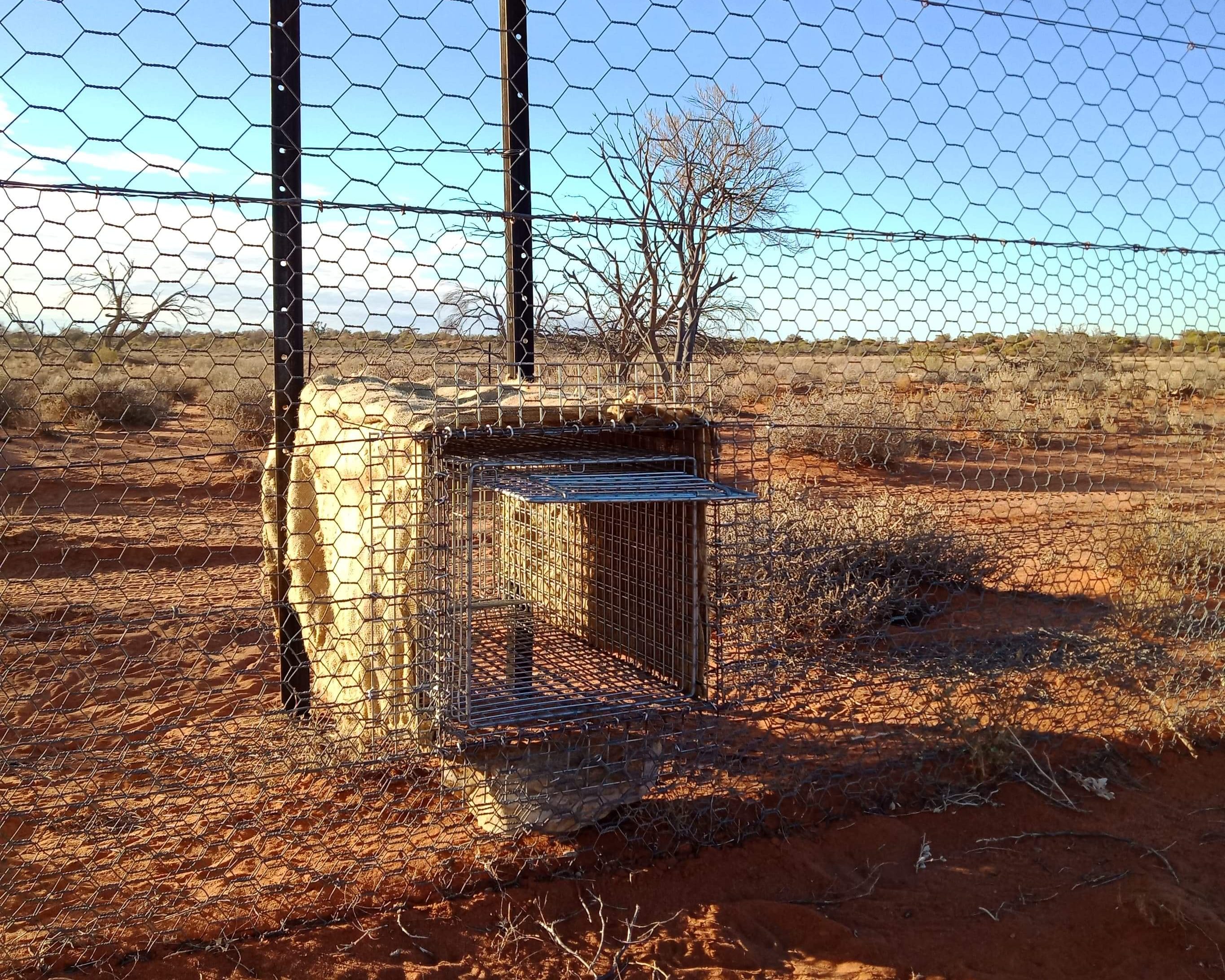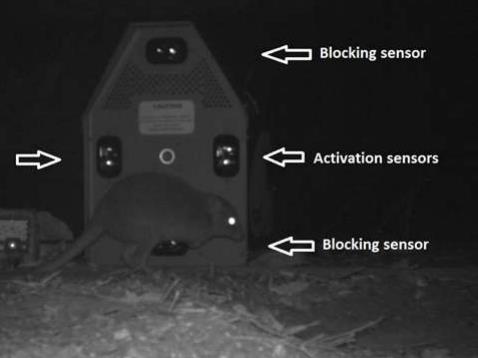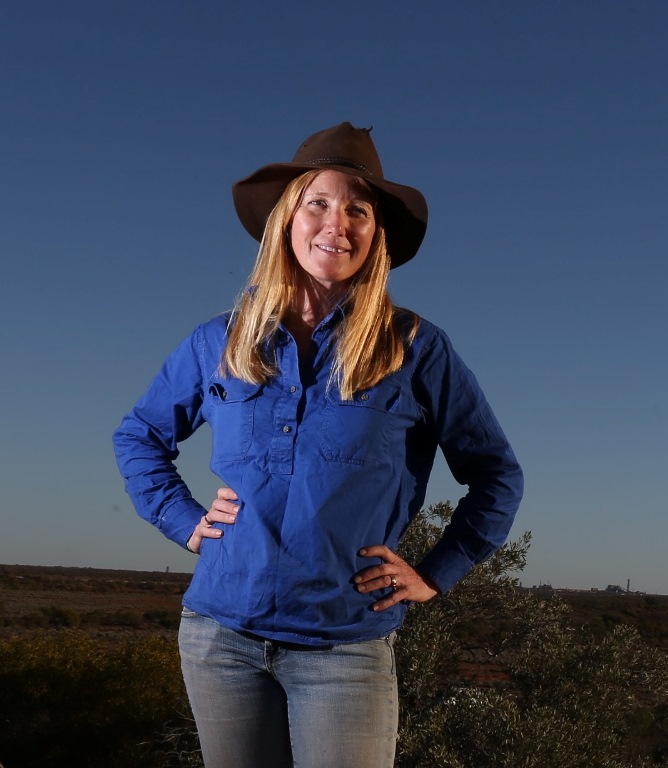Effective control of feral cats and foxes outside of fences is critical if we ever hope to re-establish vulnerable wildlife in the wider landscape.






Many native animals in the prey size range for feral cats and foxes cannot persist with these introduced predators. The attrition rates from predation are too high for the populations to sustain, and more are killed than can be replaced through breeding. Inevitably this leads to extinction. Controlling introduced predators can reduce this pressure and enable native animals to survive.
Controlling feral predators is important at Arid Recovery in our research to improve survival of native animals that can disperse beyond the fence. It is also important in keeping the core reserve feral-free. By keeping the numbers of feral animals down in the surrounding area, we help to prevent incursions into the reserve. To do this, we use a combination of trapping, baiting, shooting and trialing new technologies.
Trapping
Arid Recovery has a permanent set of cat and fox traps surrounding the reserve. These are hooked up to Australia’s first ever remote trap-checking system, powered by Observant technology. Every trap has a solar-powered communication box. If any trap goes off, it will send us a text message instantly. This enables us to respond as soon as possible to any animal captured, minimise the time animals spend in traps, and improve the welfare of trapped animals. This system has proven very successful, and we have removed an average of 60 cats and foxes per year.
In 2018, Arid Recovery installed a series of ‘breach traps’, connected to the Observant system to ensure rapid responses to animal captures. These breach traps are permanently installed into the fence, raised ~50cm above the ground and unbaited, to target individual animals which are intent on entering the reserve. To date, we have been pleased with their results – they have captured several large feral cats, as well as quolls which had jumped out of the reserve. The quolls were then re-released into the reserve.
Lures
We have trialled many lures for cats and foxes. We have found the most effective lures are cat urine and chicken oil. Fried chicken has also worked well. We have also used electronic devices that make a meowing noise (made by Westcare)
Shooting
On top of permanent traps, we also have a team of dedicated volunteer shooters. Some feral cats and foxes are more cautious and will never enter a trap. Shooting is therefore critical for removing them. Some volunteer shooters have removed over 50 cats and foxes. Contact us if you are from the local community and are interested in volunteering to control ferals.
Baiting
Poison baiting for foxes and cats is used extensively across Australia. Foxes readily take meat baits, so this is a very effective method for this species. However, such baiting programs need to be conducted over large areas, to prevent new animals reinvading. Large-scale operations like Bounceback in the Flinders Ranges have been remarkably successful, as they cover many properties and parks through the region. Unfortunately, many smaller-scale baiting operations that only encompass a single park or reserve are less effective.There are now baits specifically designed for cats: Eradicat and Curiosity. These are designed to be the perfect size for a cat meal, have a smell favoured by cats, and contain a cat-specific toxin, sometimes within a small capsule. The scent and the capsule help increase the likelihood that only a cat will be killed by the bait. Cats typically don’t chew food, so they swallow baits whole, capsule and all. Meanwhile native animals that chew their food, find the capsule, and spit it out.
Both Eradicat and Curiosity have been trialled at Arid Recovery, with mixed success (see here). Some baiting was incredibly successful, with 80% of cats removed. Other baiting events had no measurable impact whatsoever. This variation is probably because baiting is only effective when cats are hungry. If there is an abundance of live prey about, cats are rarely hungry and therefore unlikely to be interested in old meat.
Despite these issues, cat baiting is still a valuable tool. It can be used in a targeted way to reduce cat density at critical times, when most cats are hungry. Baits can also be an effective means of controlling cats around dumps, as these cats are more used to scavenging. Cat baits continue to be refined and tested so we can expect them to be more effective over time.
Felixers
One method of improving the efficiency of feral cat control is to improve the delivery system. To do so requires innovation. One such innovation is the Felixer, developed and patented by the South Australian ecological consultancy Ecological Horizons and commercialised by Australian not-for-profit company Thylation. The ideas man behind this innovation is John Read, one of the co-founders of Arid Recovery, whose forthcoming book “Among The Pigeons” describes the invention of Felixers and also other feral animal control trials at Arid Recovery and beyond www.johnlread.com.
Felixers were developed as a novel, humane and automated tool to help control both feral cats and foxes. The machines are solar-powered and use an array of range-finder sensors to distinguish cats and foxes from other non-target wildlife, humans and vehicles.
If a cat or fox is identified, the Felixer sprays a measured dose of toxic gel. The system then resets itself ready for another firing, and is capable of holding 20 gel cartridges.
The advantage of this system is that it not only target-specific, but takes advantage of feral cats’ desire to fastidiously clean themselves. Whilst grooming, the animals injest the toxin. This is a marked improvement on traditional techniques – it overcomes cat’s reluctance to take baits and avoids the need to frequently check and re-bait traps.
Felixers take photographs every time the range-finding sensors are intercepted, and the inbuilt, and updateable, algorithm determines whether the intercept was from a target or non-target, and will only fire upon a target. Each image is labelled with whether the Felixer was fired or not, and date, time, temperature, battery power, lure played, and detailed accounts of the sensor activations are also recorded. All of this information can be used by site managers and the Felixer management team to optimise performance.
Arid Recovery trials
Felixers are currently being trialled in 11 locations around the country, including Arid Recovery. In early 2018, a five week trial outside the Arid Recovery perimeter, in conjunction with BHP, resulted in 98% efficiency at delivering doses to target cats and foxes. A total of 39 cats and 1 fox were sprayed, along with a single non-target kangaroo, which is unlikely to have been affected at all - an adult kangaroo would need to consume the full volume of 8 Felixer cartridges for a lethal dose.
People, vehicles, kangaroos, birds, lizards, rodents, rabbits, bettongs and a western quoll were also photographed by Felixers during the trial, but were all successfully identified as non-targets.
Not every cat and fox which passed the Felixers was fired upon. However, three cats were fired upon within 10 minutes of first passing a Felixer and others were targeted in the following days. This trial showed that Felixers can be used in the region without harming native wildlife or workers, and offered insights into how the algorithm can be improved to increase feral cat targeting around Roxby Downs. A full report on the trial can be found here.
Arid Recovery has also hosted trials in our Red Lake paddock, the results of which are currently being analysed for publication.
The future
At Arid Recovery, we are always creating and trialling new methods for effective cat and fox control. We are also researching aspects of cat and fox ecology to better understand these predators.
We recognise that cats and foxes will never be eradicated from the Australian landscape. Our aim instead is to facilitate coexistence of vulnerable native wildlife with introduced predators. Developing effective predator control is a critical part of stacking the odds in the natives’ favour.

















